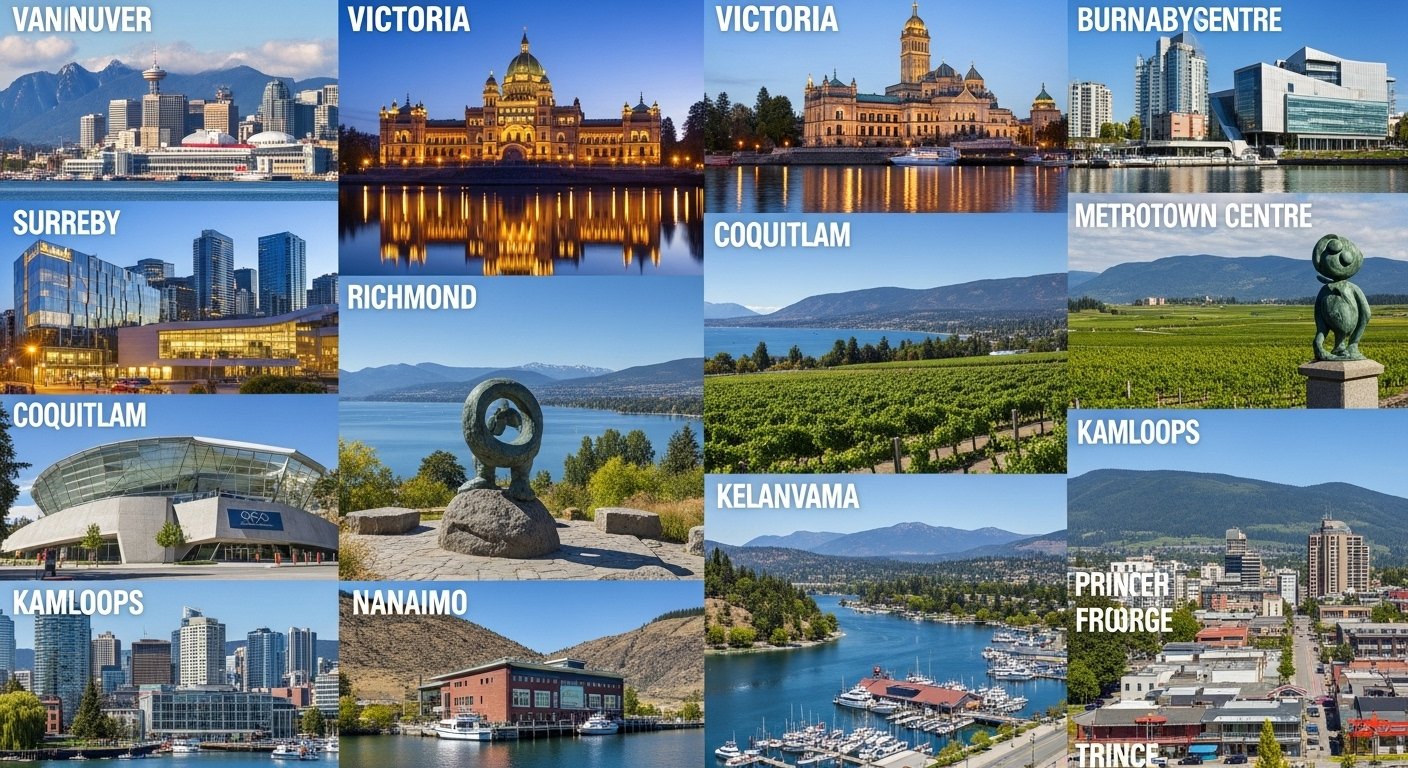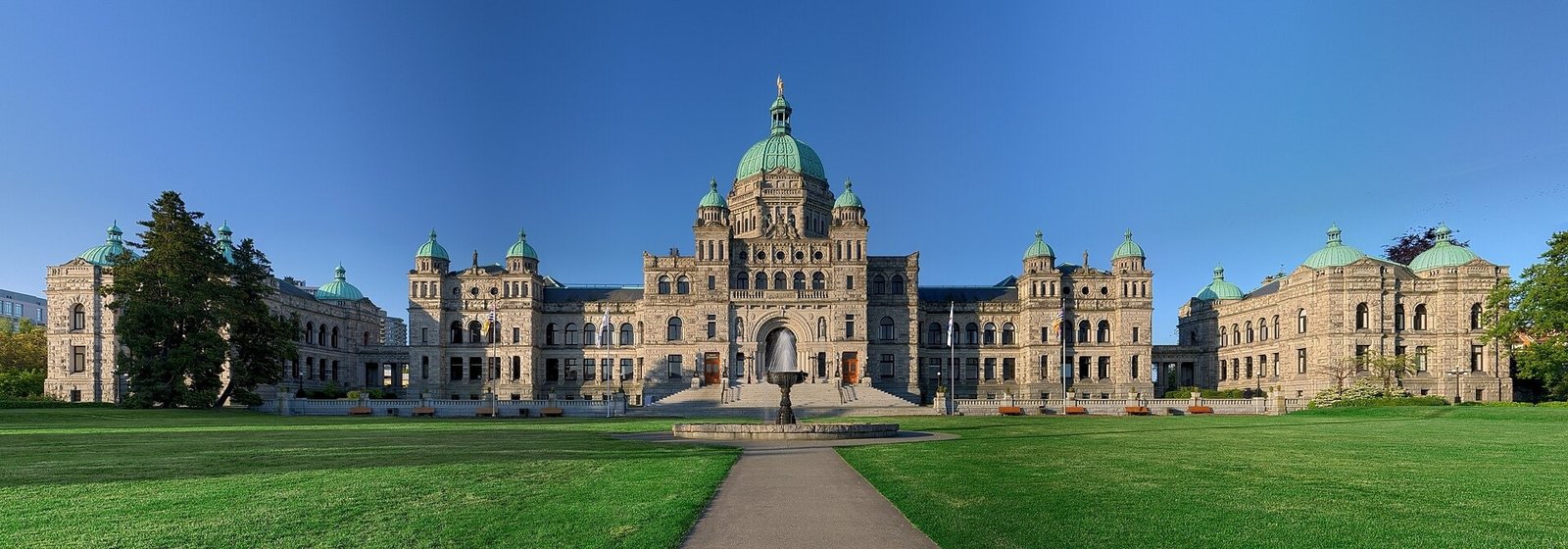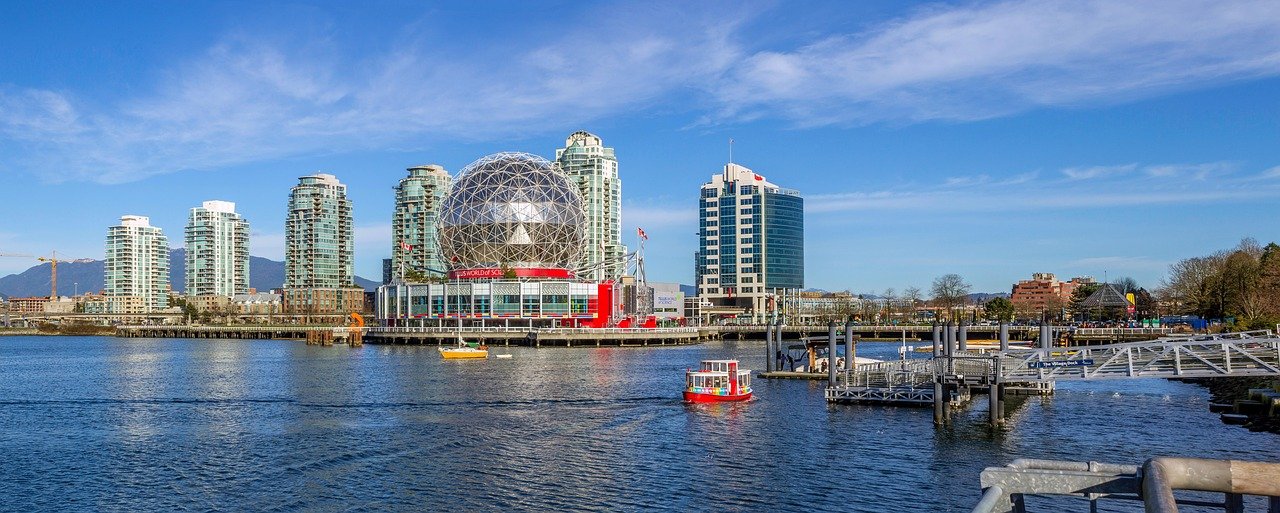
British Columbia News, Insights & Information
British Columbia today stands as one of Canada’s most diverse and geographically unique provinces, attracting global attention for its natural beauty, economic vitality, and cultural richness. Located on the western edge of the country, British Columbia spans over 944,000 square kilometers, ranging from the rugged Pacific coastline to the towering peaks of the Rocky Mountains. It is home to more than 5.7 million people, with major urban centers like Vancouver and Victoria playing key roles in Canada’s innovation and trade sectors.
The province boasts a wide variety of ecosystems, including temperate rainforests, alpine tundra, and fertile valleys, making it a global hotspot for biodiversity and environmental research. With growing investments in clean energy, sustainable tourism, and technology, British Columbia today is not only a leader in natural conservation but also an economic powerhouse. Here, we will provide an in-depth exploration of British Columbia’s geography, climate, natural features, and current significance, offering readers accurate, up-to-date information on what makes this province such an important part of Canada’s identity. Read on to discover everything you need to know about British Columbia today.
Geography and Natural Features
British Columbia (B.C.), at approximately 944,735 km², is Canada’s third‑largest province by area. From its Pacific Ocean coastline to the Rocky Mountains and Yukon border, B.C.’s geography is incredibly varied and dramatic. Mountains cover roughly 75 % of the province’s land area, forests occupy around 60 %, and only ~3 %–5 % is considered suitable for agriculture.
| Feature | Statistic | Description |
|---|---|---|
| Province area | ~944,735 km² | Roughly the size of France, Germany & Netherlands combined (WelcomeBC) |
| Mountain coverage | 75 % of province | Includes Coast, Columbia, Rocky, Selkirk, Purcell, Insular ranges |
| Forest cover | ~60 % (~55 m ha) | Temperate rainforest to interior pine and spruce forests |
| Arable land | ~3–5 % | Concentrated in floodplains, valleys (Fraser, Okanagan, Peace) |
| Coastline length | ~27,000 km | Includes ~6,000 islands and fjords |
| Number of islands | ~6,000 | Most along coast; many are uninhabited |
| Longest river | Fraser River – 1,375 km | Drains ~220,000 km²; average discharge ~3,475 m³/s |
| Largest lake | Williston Lake – ~1,761 km² | Canada’s largest man-made lake |
| Old growth forest area | ~13.7 m ha | ~27 % of forested area (depending on site index definitions) |
| Biogeoclimatic zones | 14 defined zones | Range from coastal Douglas‑fir to alpine tundra |
| Alpine/tundra/icefields | ~35 % (~33 m ha) | Non‑forested high elevation zones |
| Grassland | ~1 m ha | Areas like Okanagan, Similkameen, Peace valleys |
History and Culture
BC has a deep Indigenous heritage: First Nations have inhabited the region for millennia. Hundreds of distinct Indigenous languages and cultures (Coast Salish, Haida, Tsimshian, Interior Salish, etc.) flourished, as evidenced by oral histories and archaeological sites dating back over 10,000 years. European contact began in the late 18th century: Spanish explorers (Juan Pérez 1774) and British captains (James Cook 1778, George Vancouver 1792) charted the coasten. The fur trade (HBC, North West Company) grew in the early 1800s, establishing forts like Fort Vancouver and fur brigades into the Rockies.
Gold rushes transformed BC: the Fraser Canyon Gold Rush (1858) brought thousands of settlers and led Britain to declare the mainland a colony. Colonel Richard Moody founded New Westminster (1859) as capital of the Colony of British Columbia. Vancouver Island had been a separate colony since 1849 (capital Victoria). In 1866 the two colonies united under one government (New Westminster capital). In 1871 BC joined Canadian Confederation as Canada’s sixth provinceen, after Ottawa promised to build a transcontinental railroad to link the new province.
In the late 19th and early 20th centuries, the completion of the Canadian Pacific Railway (1885) and immigration (especially Chinese labourers) rapidly integrated BC with the rest of Canada. BC grew through timber, mining and agriculture. During World Wars, BC contributed disproportionally large numbers of troops. Postwar, leaders like Premier W.A.C. Bennett (1950s–70s) developed hydroelectric dams (W.A.C. Bennett Dam) and modernized the economy. Expo 86 (Vancouver) and the 2010 Winter Olympics boosted global awareness. More recent history includes political shifts (the long dominance of Social Credit and later the BC Liberals), as well as debates over pipelines (Enbridge Northern Gateway was rejected) and environmental protection.
Economy and Leading Industries
British Columbia’s economy has transitioned from resource-based to service-oriented, though natural resources remain important. Forestry and logging have historically dominated the economy, along with mining and fishing. Today BC exports significant volumes of lumber, pulp, minerals (copper, coal, potash) and natural gas. Only about 5% of land is arable, but the fertile Fraser and Okanagan valleys support fruit and wine production. Tourism (skiing, parks, city tourism) is a major sector, and film/video production (“Hollywood North”) is nationally significant.
Vancouver, as BC’s economic hub, hosts many head offices in finance, high tech, and real estate. The Port of Vancouver is Canada’s busiest port and handles goods to Asia, the Americas and beyond. In 2020 BC’s GDP was about $309 billion (3rd in Canada) with a per capita income well above the national average. Services dominate the workforce: roughly 72% of BC’s jobs are in finance, insurance, real estate, retail and other services. Construction, technology (software, biotech, clean tech), and health care also drive growth. Economic trends include urban housing booms (especially in Vancouver), a growing green energy sector, and recent pressures such as housing affordability and shifts due to trade disruptions.
Overview of British Columbia’s Economy
British Columbia’s economy is the fourth largest in Canada by GDP, following Ontario, Quebec, and Alberta. It is service-oriented, with services accounting for over 75% of its total GDP. However, resource-based sectors like forestry, mining, and energy remain foundational to its economic identity. B.C.’s west coast ports, particularly in Vancouver, position it as a key player in international trade with the Asia-Pacific region.
| Indicator | Data (2024) | Description |
|---|---|---|
| GDP (Nominal) | CAD $428 billion | 4th largest in Canada |
| Unemployment Rate | 5.6% | Among the lowest in the country |
| Population | 5.6 million | Rapidly growing, urban-focused |
| Main Export Partners | U.S., China, Japan, South Korea | Asia-Pacific trade dominates |
| Major Metro Area | Vancouver | Economic heart of B.C. |
Overview of British Columbia’s Leading Industries (2025)
British Columbia’s economy is supported by a well-balanced blend of traditional sectors and emerging industries. Below is an overview of the top-performing industries:
British Columbia Economic Sectors Overview
| Sector | Contribution to GDP (CAD billion) | Employment | Key Exports / Markets | Major Players / Regions |
|---|---|---|---|---|
| Technology & Innovation | ~37 | ~160,000 | Software, AI, biotech, tech services | Vancouver, Victoria, Kelowna |
| Forestry & Mining | ~18 (resources sector) | ~55,000 | Lumber, critical minerals, pulp | Prince George, Cranbrook, mining regions |
| Clean Energy & Gov’t | ~9 (energy & clean tech) | ~13,000 | Hydro, wind, hydrogen | Site C, Revelstoke, new wind projects |
| Tourism & Hospitality | ~9.5 | ~170,000 | Nature tourism & cultural travel | Whistler, Victoria, Okanagan, Vancouver |
| Film & TV / Digital Media | ~4.8 | ~72,000 | Film, series, VFX, animation | Vancouver, Burnaby studios, North Shore |
| Agriculture & Aquaculture | ~3.3 | ~36,000 | Wine, berries, salmon exports | Fraser Valley, Okanagan, Vancouver Island |
| International Trade (Port) | Export value approx. 70 | N/A | Timber, minerals, seafood, tech | Port of Vancouver, Deltaport |
Major Cities and Iconic Destinations
British Columbia is home to a diverse array of cities and towns, each with its own distinct character, economic strengths, and scenic beauty. From bustling urban hubs like Vancouver to culturally rich and historically significant locales such as Victoria, the province offers a rich mosaic of experiences for residents and visitors alike.
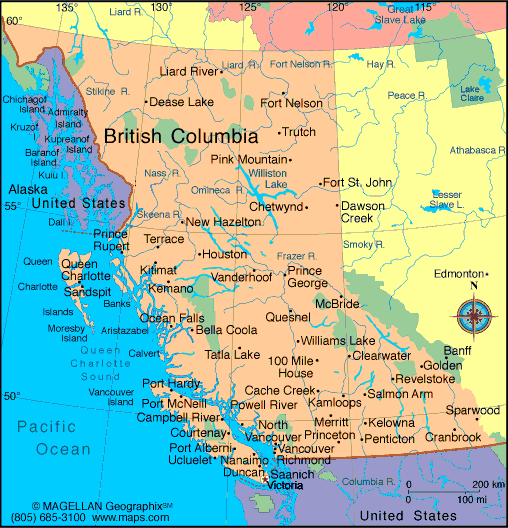
British Columbia’s urban development is concentrated in its southern regions, particularly along the Pacific coastline and near the U.S. border. Below is a breakdown of the most prominent cities in the province, showcasing population statistics, economic drivers, and distinctive features:
Population of British Columbia Cities (2011–2025)
| City | 2011 | 2016 | 2024 | 2025 | Δ% (2025 vs 2024) |
|---|---|---|---|---|---|
| Vancouver | 631,486 | 603,502 | 561,284 | 556,219 | –0.90% |
| Surrey | 517,887 | 468,251 | 398,537 | 390,587 | –1.99% |
| Burnaby | 232,755 | 223,218 | 208,765 | 207,025 | –0.83% |
| Richmond | 198,309 | 190,473 | 178,574 | 177,140 | –0.80% |
| Abbotsford | 141,397 | 133,497 | 121,765 | 120,373 | –1.14% |
| Coquitlam | 139,284 | 126,804 | 109,120 | 107,090 | –1.86% |
| Saanich | 114,148 | 109,752 | 103,068 | 102,261 | –0.78% |
| Kelowna | 127,380 | 117,312 | 102,832 | 101,152 | –1.63% |
| Delta | 102,238 | 99,863 | 96,177 | 95,726 | –0.47% |
| Langley | 117,285 | 104,177 | 86,182 | 84,164 | –2.34% |
| North Vancouver | 85,935 | 84,412 | 82,031 | 81,738 | –0.36% |
| Kamloops | 90,280 | 85,678 | 78,798 | 77,977 | –1.04% |
| Nanaimo | 90,504 | 83,810 | 74,114 | 72,984 | –1.53% |
| Victoria | 85,792 | 80,017 | 71,575 | 70,584 | –1.38% |
| Prince George | 74,003 | 71,974 | 68,843 | 68,461 | –0.55% |
| Chilliwack | 83,788 | 77,936 | 69,411 | 68,413 | –1.44% |
| Maple Ridge | 82,256 | 76,052 | 67,084 | 66,040 | –1.56% |
| New Westminster | 70,996 | 65,976 | 58,672 | 57,818 | –1.46% |
| Port Coquitlam | 58,612 | 55,958 | 51,959 | 51,480 | –0.92% |
| West Vancouver | 42,473 | 42,694 | 43,050 | 43,095 | 0.001% |
| Vernon | 40,116 | 38,180 | 35,275 | 34,928 | –0.98% |
| Mission | 38,833 | 36,426 | 32,881 | 32,463 | –1.27% |
| Port Moody | 33,551 | 33,011 | 32,165 | 32,061 | –0.32% |
| Penticton | 33,761 | 32,877 | 31,510 | 31,344 | –0.53% |
| Campbell River | 32,588 | 31,186 | 29,067 | 28,813 | –0.88% |
| West Kelowna | 32,655 | 30,902 | 28,291 | 27,980 | –1.10% |
| North Cowichan | 29,676 | 28,807 | 27,469 | 27,306 | –0.59% |
| Courtenay | 25,599 | 24,216 | 22,157 | 21,912 | –1.10% |
| Langford | 35,342 | 29,228 | 21,568 | 20,764 | –3.73% |
| White Rock | 19,952 | 19,339 | 18,397 | 18,283 | –0.62% |
| Cranbrook | 20,047 | 19,319 | 18,209 | 18,075 | –0.74% |
| Oak Bay | 18,094 | 18,015 | 17,889 | 17,874 | –0.09% |
| Port Alberni | 17,678 | 17,743 | 17,847 | 17,861 | 0.0007% |
| Salmon Arm | 17,706 | 17,464 | 17,084 | 17,037 | –0.27% |
| Pitt Meadows | 18,573 | 17,736 | 16,475 | 16,323 | –0.92% |
| Fort St. John | 20,155 | 18,609 | 16,378 | 16,119 | –1.58% |
| Colwood | 16,859 | 16,093 | 14,939 | 14,801 | –0.93% |
| Central Saanich | 16,814 | 15,936 | 14,626 | 14,470 | –1.07% |
| Esquimalt | 17,655 | 16,209 | 14,138 | 13,898 | –1.69% |
| Squamish | 19,512 | 17,158 | 13,968 | 13,613 | –2.54% |
| Powell River | 13,157 | 13,165 | 13,178 | 13,179 | 0.0001% |
| Prince Rupert | 12,220 | 12,508 | 12,983 | 13,044 | 0.0047% |
| Comox | 14,028 | 13,627 | 13,009 | 12,934 | –0.58% |
| Terrace | 11,643 | 11,486 | 11,239 | 11,209 | –0.27% |
| Parksville | 12,514 | 11,977 | 11,165 | 11,068 | –0.87% |
| Williams Lake | 10,753 | 10,832 | 10,960 | 10,976 | 0.0015% |
| North Saanich | 11,249 | 11,089 | 10,838 | 10,807 | –0.29% |
| Summerland | 11,615 | 11,280 | 10,764 | 10,701 | –0.58% |
| Dawson Creek | 12,178 | 11,583 | 10,691 | 10,584 | –1.00% |
| Sidney | 11,672 | 11,178 | 10,431 | 10,341 | –0.86% |
| Lake Country | 12,922 | 11,708 | 9,998 | 9,803 | –1.95% |
| Coldstream | 10,648 | 10,314 | 9,801 | 9,739 | –0.64% |
| Nelson | 10,572 | 10,230 | 9,706 | 9,642 | –0.66% |
| Sooke | 13,001 | 11,435 | 9,312 | 9,076 | –2.53% |
| Sechelt | 10,216 | 9,291 | 7,982 | 7,832 | –1.88% |
| View Royal | 10,408 | 9,381 | 7,944 | 7,781 | –2.06% |
| Whistler | 11,854 | 9,824 | 7,274 | 7,006 | –3.69% |
Travel and Tourism in British Columbia (B.C.)
When it comes to world-class travel destinations, British Columbia (B.C.) stands at the top of the list. With its unmatched natural beauty, rich cultural heritage, and endless opportunities for adventure, B.C. offers something for every kind of traveler. From snow-covered ski resorts in Whistler to the lush rainforests of Vancouver Island, this western Canadian province blends wild nature with modern comforts. Whether you’re chasing outdoor thrills, cultural experiences, or a peaceful retreat surrounded by mountains and ocean, British Columbia is the perfect destination—in every season, and for every traveler.
Tourism is a major industry due to BC’s scenery and cities. The province boasts 7 national parks (more than any other province) and hundreds of provincial parks. Outdoor attractions include Garibaldi and Pacific Rim National Parks (hiking, beaches, surfing), Yoho and Glacier (Rocky Mountain scenery), and the Great Bear Rainforest (coastal rainforest with grizzly and Spirit Bear). Ski resorts (Whistler Blackcomb, Big White, Sun Peaks) draw winter sports fans. The coast offers whale-watching (orcas near Victoria, humpbacks off Vancouver Island) and scenic cruising. Vancouver Island attractions include Victoria’s Inner Harbour and Butchart Gardens, and Cathedral Grove’s ancient Douglas-firs.
Cities and culture also attract visitors. Vancouver’s Stanley Park (totem poles, Seawall), Granville Island, and historic Gastown are tourist staples. Victoria’s colonial architecture, the Royal BC Museum and Parliament Buildings are major draws. Small towns like Whistler, Kelowna (wine country), and Harrison Hot Springs are popular. Festivals (e.g. Vancouver International Film Festival, Celebration of Light fireworks) add to urban tourism. Overseas visitors mostly arrive via Vancouver International Airport or cruise ships to Vancouver and Victoria. Overall Vancouver, Victoria and Whistler rank among BC’s most-visited destinations.
Top British Columbia Tourism Destinations
| Destination | Region | Key Highlights | Annual Visitors (Approx.) |
|---|---|---|---|
| Whistler | Sea-to-Sky Corridor | Skiing, biking, luxury resorts, host of Winter Olympics events | 2.7 million |
| Tofino | Vancouver Island | Surfing, beaches, Indigenous culture, whale watching | 1 million |
| Okanagan Valley | Southern Interior | Vineyards, lakes, wineries, fruit orchards | 3.2 million |
| Haida Gwaii | Northern Coast | Indigenous heritage, remote nature, UNESCO World Heritage Site | 50,000 |
| Gulf Islands | Strait of Georgia | Boating, art communities, organic farms | 300,000 |
| Yoho National Park | Canadian Rockies | Waterfalls, hiking, Lake O’Hara, fossil beds | 700,000 |
| Stanley Park | Vancouver | Urban park, seawall, totem poles, aquarium | 8 million |
| Capilano Suspension Bridge | North Vancouver | Suspension bridge, rainforest tours, cliffwalk | 1.2 million |
| Barkerville Historic Town | Cariboo Region | Restored Gold Rush town, living museum | 60,000 |
| Pacific Rim National Park | Vancouver Island | Rainforest trails, beaches, biodiversity | 1.3 million |
From the towering skyscrapers of downtown Vancouver to the tranquil beaches of Tofino, British Columbia’s cities and destinations together shape a province rich in diversity, opportunity, and beauty.
Government and Politics
BC is a parliamentary province under Canada’s constitutional monarchy. The British Columbia Parliament Buildings (Victoria) house an 87-member legislature elected by first-past-the-post. The Lieutenant Governor (representing the Crown) formally appoints the Premier, who is usually the leader of the largest party. The current government (as of 2025) is the center-left BC New Democratic Party (NDP) led by Premier David Eby. The former BC Liberal Party (a centre-right coalition separate from the federal Liberals) governed 2001–2017; it was renamed BC United in 2023. The Green Party has a small but notable presence, having supported an NDP minority government from 2017–2020.
Recent elections reflect this balance: a hung parliament in 2017 led to an NDP minority (with Green support), and in 2020 the NDP won a slim majority. BC’s politics have featured dramatic swings – e.g. the NDP first formed a government in 1972 and again in 1991, while the 2001 BC Liberal landslide took 77 of 79 seats. Provincial-federal relations are often tense: BC has opposed some federal policies (e.g. carbon pricing changes, opposition to the Trans Mountain pipeline expansion). Environmental policies (carbon tax implemented in 2008) and resource projects (like the cancelled Enbridge Northern Gateway pipeline) have been major political issues.
British Columbia Local News
Education
Education in BC is overseen provincially and includes publicly funded K–12 schooling plus private (“independent”) and homeschooling options. School is compulsory ages 6–16, though most students complete Grade 12. In 2020 the high school graduation rate was about 86%. There were ~665,000 students in K–12 (2019–20): ~576,000 (86.5%) in public schools and ~87,000 (13.1%) in independent schools (the largest private school sector in Canada). Funding for public K–12 in 2020–21 was about CAD $5.0 billion (≈22% of provincial budget). BC also operates a province-wide Francophone school board for French-language education.
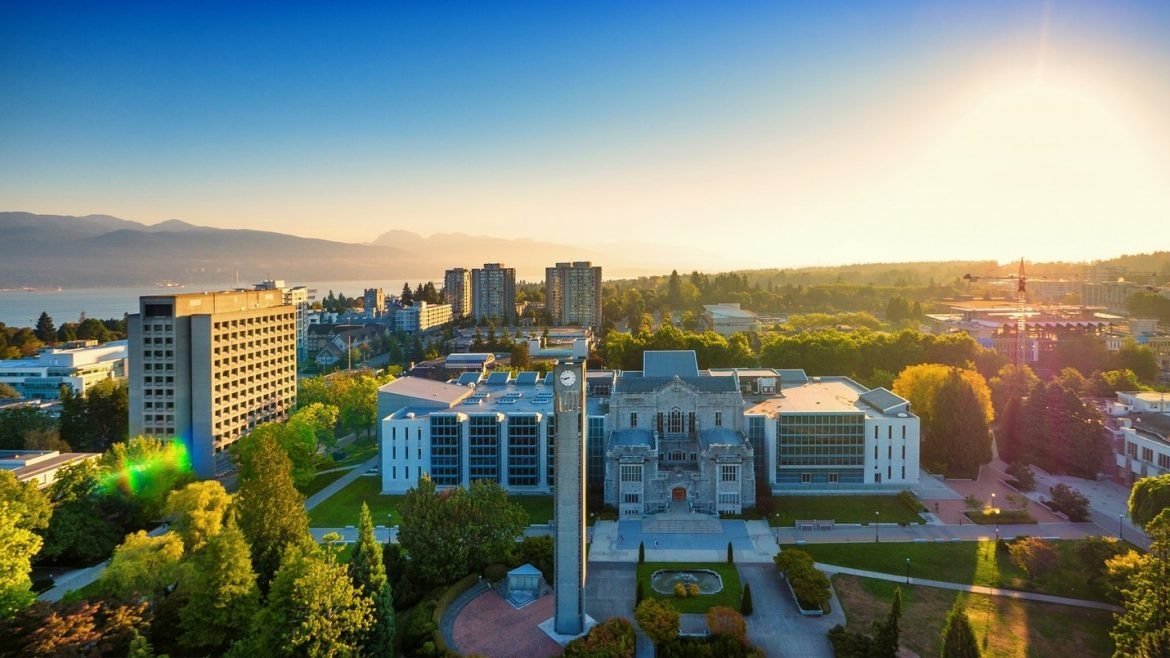
Higher education is centered in universities and colleges. Major research universities include the University of British Columbia (UBC, campuses in Vancouver and Kelowna), Simon Fraser University (Burnaby/Surrey), University of Victoria (Victoria), University of Northern BC (Prince George), and Thompson Rivers University (Kamloops) – plus numerous community colleges. These institutions are known for research in forestry, ocean sciences, computer science, and other fields. BC is home to specialized institutes (e.g. TRIUMF particle accelerator at UBC, Climate Research at U Vic). Literacy rates are very high (~99%), and a large proportion of youth pursue post-secondary studies in colleges or universities.
Transportation and Infrastructure
BC’s infrastructure supports its geography. The Trans-Canada Highway (Route 1) runs from Vancouver through Kamloops to Alberta; Highways 99 (Sea-to-Sky to Whistler) and 97 (Okanagan) also connect major regions. Remote areas rely on Highways 16 and 37 and the Cariboo and Cassiar highways. BC Ferries operates one of the world’s largest ferry systems: 25 routes linking the mainland to Vancouver Island and coastal communities. It carried ~18 million passengers (2019) and nearly 8 million vehicles in a recent year.
Air travel is vital: Vancouver International Airport (YVR) is a major hub (26.4 million passengers in 2019, #2 in Canada. Other key airports include Victoria (YYJ), Kelowna (YLW), and Abbotsford (YXX). Over 200 airports and airfields serve remote areas (e.g. Prince Rupert, Terrace, the North Coast). Rail includes passenger service (VIA Rail’s “Skeena” line to Prince George and Jasper) and luxury tourist trains (Rocky Mountaineer). Urban transit: Greater Vancouver’s TransLink runs SkyTrain (three light-rail lines), buses and SeaBus ferry; other cities have local bus systems. The Port of Vancouver and Port of Prince Rupert together handle much of BC’s trade through large container and bulk facilities.
Environment and Sustainability
BC is rich in biodiversity and has many conservation initiatives. As of 2015 about 15.5% of BC’s land and 3.2% of its water were in protected areas. The province contains extensive parks and reserves, including three UNESCO World Heritage Sites (e.g. Canadian Rocky Mountain Parks and Haida Gwaii’s SGang Gwaay). For example, the Great Bear Rainforest (6.4 million hectares) is conserved under a government–First Nations agreement, protecting >85% of its forest and 70% of old-growth habitat. Similarly, biosphere reserves (Clayoquot Sound, Pacific Salmon streams) and marine protected areas safeguard coastal ecosystems.
BC has been active on climate and sustainability. It implemented North America’s first broad carbon tax in 2008, making fossil fuels more expensive while lowering other taxes. Under the “CleanBC” plan, the province aims to cut greenhouse gas emissions 40% by 2030cleanbc.gov.bc.ca through renewable energy, clean transportation, and efficiency programs. Wildfire and drought are growing challenges with climate change (recent years have seen severe fires and floods). The province promotes renewable hydroelectricity (over 90% of its power), forest carbon projects (e.g. credit sales from the Great Bear), and collaboration with Indigenous communities on sustainability. Despite strong conservation efforts, debates continue over new pipelines, logging of remaining old-growth forests, and balancing resource development with ecological protection. Overall, BC emphasizes a “green” economy and conservation, but faces pressures from climate impacts and growing resource demands
Comprehensive Overview of British Columbia (B.C.) – Demographics, Population, Professions, and Job Sectors (2025)
| Category | Subcategory | Data / Statistics (2025) | Additional Details / Notes | Geographic Focus / Examples |
|---|---|---|---|---|
| Population & Demographics | Total Population | 5.76 million | 4th largest Canadian province | Metro Vancouver (2.7M), Victoria (430K) |
| Population Density | 6.1 people per km² | Highly concentrated in southwest BC | Dense in Metro Vancouver, sparse in north | |
| Urban vs Rural Population | 86% urban / 14% rural | Urbanization continues to grow | Major cities and suburbs | |
| Age Distribution | 0-14 yrs: 16%; 15-64 yrs: 65%; 65+ yrs: 19% | Aging population, median age 42.2 years | Older median age in Victoria | |
| Gender Ratio | 49.8% male / 50.2% female | Slightly more females | Consistent across BC | |
| Indigenous Population | ~300,000 (5.2% of total) | Over 200 First Nations groups | Spread across province, concentration in northern/interior | |
| Visible Minority Groups | 34% of total population | Fastest growing segment | South Asian (10%), Chinese (9%), Filipino (4%) | |
| Immigrant Population | 1.55 million (27%) | One of the highest immigrant proportions nationally | High concentration in Metro Vancouver | |
| Birth Rate | 1.35 children per woman | Below replacement rate | Declining birth rates mirror national trend | |
| Life Expectancy | 83.5 years | Above Canadian average | Females 85 years, Males 81 years | |
| — | Most Spoken Languages | English (70%), Punjabi (7.2%), Mandarin (5%), Cantonese (3.5%), Tagalog (2%), Farsi (1.5%) | Reflects multicultural population | Metro Vancouver, Surrey, Richmond |
| Ethnic and Language Diversity | Indigenous Languages | Over 30 spoken languages | Kwak’wala, Nuu-chah-nulth, Secwepemctsin, Halq’eméylem | Preservation programs ongoing |
| Religious Affiliation | No religion (39%), Christianity (34%), Sikhism (8%), Buddhism (4%), Islam (3.5%) | Highest non-religious percentage in Canada | Diverse religious communities | |
| Immigrants by Region | Asia-Pacific (~70%), Europe (~15%), Americas (~10%), Africa (~5%) | Significant inflow from India, China, Philippines, Iran | Vancouver, Surrey, Richmond | |
| Immigration & Migration | Recent Immigrants (last 5 years) | ~340,000 | Includes economic, family reunification, refugees | — |
| Refugees & Protected Persons | 7,500 annually | From Syria, Afghanistan, Central America | Settlement programs in Metro Vancouver | |
| International Students | 175,000+ | Mostly at UBC, SFU, UVic, BCIT | Large contributor to local economy | |
| Interprovincial Migration | Net +30,000 annually | Migration from Alberta, Ontario, Quebec | Smaller BC cities like Kelowna, Kamloops | |
| Education | Literacy Rate | 99% | Among highest globally | Universal access to K-12 education |
| K-12 Enrollment | 665,000 | Public (86%), private (13%), francophone (1%) | BC School Districts | |
| Post-Secondary Enrollment | 250,000+ | Universities and colleges | UBC, SFU, UVic, TRU, BCIT | |
| University Graduation Rate | ~72% | Varies by institution | High retention at major universities | |
| Apprenticeships & Trades Training | 35,000+ active apprentices | Programs through BCIT, colleges | Trades like plumbing, electrical, welding | |
| Workforce & Employment | Labor Force Size | 2.85 million | Full-time, part-time, self-employed | — |
| Employment Rate | 61.8% | High relative to national average | — | |
| Unemployment Rate | 5.1% | Slightly below national average | Higher in rural and Indigenous communities | |
| Youth Unemployment (15–24 yrs) | 11.5% | Higher than provincial average | Focus on education-to-work transition | |
| Job Sectors – Employment & GDP | Technology & Innovation | 160,000 employees, $37B GDP contribution | AI, software, biotech, cleantech | Vancouver, Victoria, Kelowna |
| Health Care & Social Assistance | 300,000+ employees | Aging population drives growth | Province-wide | |
| Construction & Trades | 225,000 employees | Residential, commercial, infrastructure | Lower Mainland, Kamloops, Prince George | |
| Average Salaries & Income | Median Household Income | $84,980 | Varies regionally | Higher in suburbs, lower in rural areas |
| Average Individual Income | ~$50,000 | Sector dependent | — | |
| Minimum Wage | $17.40/hr | Effective June 2025 | — | |
| Poverty Rate | 10.7% | Includes urban housing pressures | Higher in Vancouver core | |
| Housing & Real Estate | Average Home Price (Metro Van) | $1.25 million | Detached homes much higher | Vancouver, Burnaby, West Vancouver |
| Rental Vacancy Rate | 1.8% | Extremely tight market | Metro Vancouver, Victoria | |
| Social Housing Stock | 100,000+ units | Public and nonprofit-supported | Provincial and municipal programs | |
| Homelessness Estimate | 6,000+ persons (point-in-time count) | Concentrated in Vancouver, Victoria | Increasing with housing crisis | |
| Environment & Sustainability | Land Area | 944,735 km² | Diverse ecosystems | Coastal rainforests to Rocky Mountains |
| Protected Areas | 15.5% of land protected | 1,000+ parks and reserves | National parks, Indigenous conservancies | |
| Wildfire Season | Average 2,500+ fires per year | Climate change increased severity | Interior and northern BC | |
| Renewable Energy Share | 95%+ hydroelectric power | Includes wind, solar, biomass | BC Hydro leading supplier | |
| Carbon Tax Rate | $60 per tonne CO2 | North America’s first carbon tax implemented 2008 | Key driver for CleanBC plan | |
| Transportation & Infrastructure | Major Highways | Highway 1, 99, 97, 16 | Connect urban and remote areas | Sea-to-Sky Highway, Trans-Canada |
| Public Transit Usage | 500 million+ annual rides in Metro Vancouver | SkyTrain, buses, ferries | Growing ridership post-pandemic | |
| BC Ferries Network | 35+ routes | 18 million passengers/year | Vital to coastal communities | |
| Major Airports | Vancouver Intl (YVR, 26M passengers), Victoria (YYJ), Kelowna (YLW) | 2nd busiest airport in Canada | International & regional flights | |
| Culture & Society | Festivals & Events | Vancouver Int’l Film Festival, Celebration of Light, Pow Wows, Vaisakhi, Diwali, Lunar New Year | Strong multicultural celebrations | Vancouver, Surrey, Victoria |
| Sports Teams | Vancouver Canucks (NHL), BC Lions (CFL), Vancouver Whitecaps (MLS) | Professional sports drive community spirit | Major venues in Vancouver | |
| Arts & Museums | Museum of Anthropology (UBC), Royal BC Museum, Vancouver Art Gallery | Strong Indigenous arts representation | Vancouver, Victoria | |
| Health & Social Services | Healthcare Spending | $20+ billion provincial healthcare budget | Covers hospitals, community health, mental health | Provincial Health Services Authority (PHSA) |
| Hospital Beds | ~8,200 beds | Includes acute, chronic, and rehab beds | Vancouver General, Royal Jubilee, Kelowna General | |
| Mental Health Services | Increasing funding and initiatives | Focus on youth and Indigenous populations | Province-wide | |
| Life Expectancy | 83.5 years | One of the highest in Canada | Females 85, males 81 years | |
| Politics & Governance | Provincial Government | Parliamentary system, 87 MLAs, Premier David Eby (NDP) | Stable center-left government since 2020 | Capital: Victoria |
| Major Political Parties | NDP, BC United (formerly Liberals), Green Party | NDP holds majority as of 2025 | Shifting regional support in Interior and North | |
| Federal Electoral Districts | 42 seats in House of Commons | BC has growing influence in federal politics | Mix of urban and rural ridings | |
| Tourism & Recreation | Annual Visitors | 25+ million visitors annually | Domestic and international tourists | Vancouver, Whistler, Victoria, Okanagan |
| Ski Resorts | Whistler Blackcomb (largest in North America), Big White, Sun Peaks | Winter sports major economic driver | Sea-to-Sky corridor, Okanagan | |
| National Parks | 7 major national parks, including Pacific Rim, Yoho, Glacier | UNESCO World Heritage Sites | Coastal and Rocky Mountains | |
| Outdoor Activities | Hiking, kayaking, whale watching, mountain biking | Vital to tourism economy | Everywhere, especially Vancouver Island, Sea-to-Sky |
